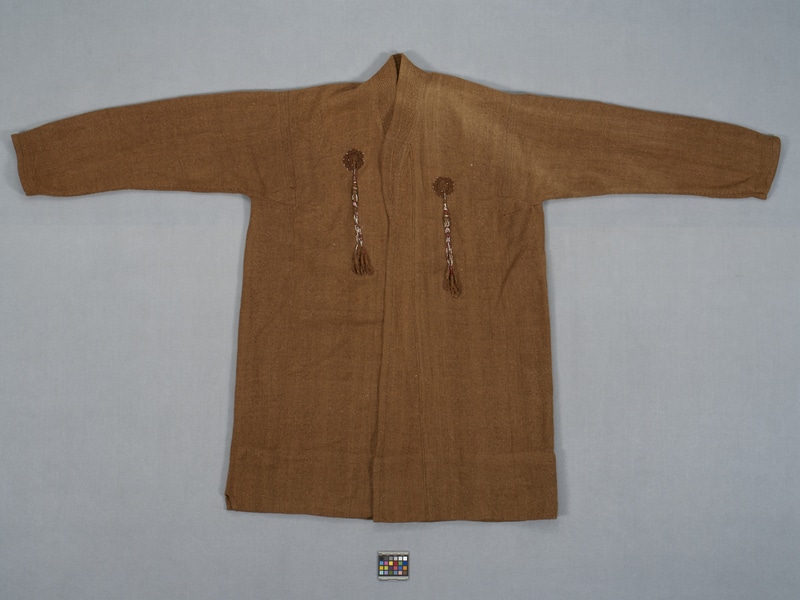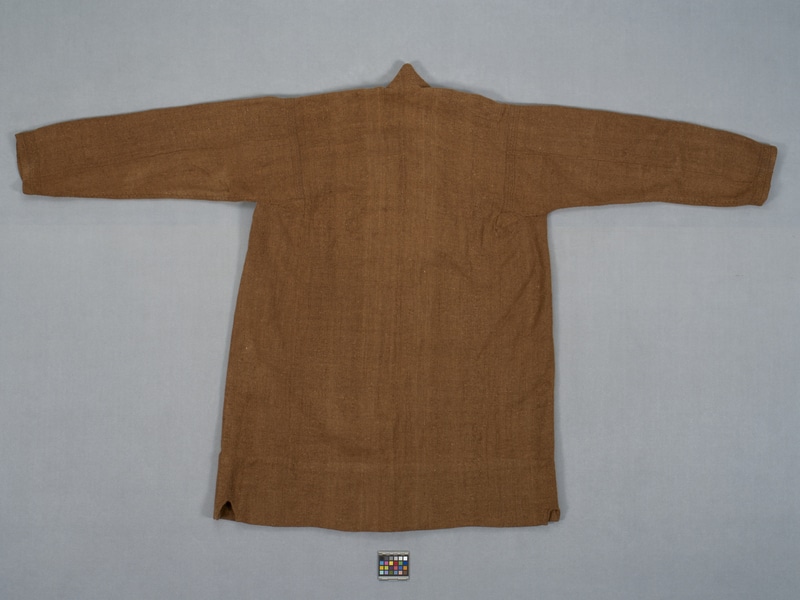Coat Item Number: 2878/13 from the MOA: University of British Columbia


Description
A man’s brown winter coat, or robe, open at the front with long sleeves. The brown wool (“pusp”) is natural, undyed sheep’s wool. Around the collar and the shoulder sections there is an embroidered design in the same brown wool yarn. On the front of the coat, there are two decorative tassels on either side of the opening, near where the wearer’s upper chest would be. The tassel is sewn on to the coat at the centre point of an embroidered round design, also in the same brown wool yarn. The tassel is mainly brown but there are coloured threads wrapped around the brown thread with silver being the most predominant thread colour. At the end of the tassel, the strands are broken into four sections and there is a woven design at the end of each of the sections.
Specific Techniques
In Chitrali (or Kho) culture, men weave this specialty woolen cloth (both men and women spin). The wool is called "pusp" in Khowar language. There are weaver specialists living in the Upper Chitral area who weave long strips of this soft sheep's wool into strips called "pati", all in natural undyed colours. The coats are then assembled by tailors living in Chitral town who sew the garments together with a treadle sewing machine. After assembling the "chuga", they are sent to the homes of some skilled Chitrali (Kho) women sewers who hand-embroider the subtle designs on the collars and on the area where the sleeves attached to the body of the garment. The decorative tassels (also made by women) are added last.
Narrative
This is the speciality item in the district of Chitral, Pakistan. These coats or robes are a must in winter for Chitrali men with the means to buy them. They are also much coveted by the Kalash'a, both men and some women. However as they are an expensive item, only the wealthiest can afford them. The hem of this coat has ben turned up and stitched by Kon Jeki from Brun Village, Bumburet Valley, to a length appropriate for a woman.
Item History
- Made in Chitral, Northwest Frontier, Pakistan during 1976
- Collected during 1981
- Owned by Tamarin Productions Inc. before May 4, 2011
- Received from Tamarin Productions Inc. (Seller) and Ruth Read Bequest (Funding source) on May 4, 2011
What
- Name
- Coat
- Identification Number
- 2878/13
- Type of Item
- coat
- Material
- sheep wool fibre and fibre
- Overall
- height 129.5 cm, width 92.0 cm
- Sleeve
- height 77.6 cm, width 18.5 cm
Who
- Culture
- Chitrali
- Previous Owner
- Tamarin Productions Inc.
- Received from
- Tamarin Productions Inc. (Seller) and Ruth Read Bequest (Funding source)
Where
- Holding Institution
- MOA: University of British Columbia
- Made in
- Chitral, Northwest Frontier, Pakistan
When
- Creation Date
- during 1976
- Collection Date
- during 1981
- Ownership Date
- before May 4, 2011
- Acquisition Date
- on May 4, 2011
Other
- Item Classes
- textiles
- Condition
- good
- Accession Number
- 2878/0013